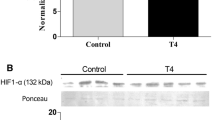Abstract.
Hypermetabolic state in hyperthyroidism is associated with tissue oxidative injury. Available data indicate that hyperthyroid tissues exhibit an increased ROS and RNS production. The increased mitochondrial ROS generation is a side effect of the enhanced level of electron carriers, by which hyperthyroid tissues increase their metabolic capacity. Investigations of antioxidant defence system have returned controversial results. Moreover, other thyroid hormone-linked biochemical changes increase tissue susceptibility to oxidative challenge, which exacerbates the injury and dysfunction they suffer under stressful conditions. Mitochondria, as a primary target for oxidative stress, might account for hyperthyroidism linked tissue dysfunction. This is consistent with the inverse relationship found between functional recovery of ischemic hyperthyroid hearts and mitochondrial oxidative damage and respiration impairment. However, thyroid hormone-activated mitochondrial mechanisms provide protection against excessive tissue dysfunction, including increased expression of uncoupling proteins, proteolytic enzymes and transcriptional coactivator PGC-1, and stimulate opening of permeability transition pores.
Similar content being viewed by others
Author information
Authors and Affiliations
Corresponding author
Additional information
Received 3 October 2005; received after revision 28 October 2005; accepted 1 November 2005
Rights and permissions
About this article
Cite this article
Venditti, P., Meo, S.D. Thyroid hormone-induced oxidative stress. Cell. Mol. Life Sci. 63, 414–434 (2006). https://doi.org/10.1007/s00018-005-5457-9
Published:
Issue Date:
DOI: https://doi.org/10.1007/s00018-005-5457-9



